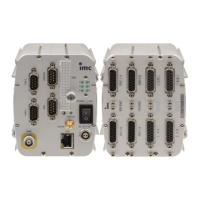© 2018 imc Test & Measurement GmbH
imc C-SERIES - Manual, Version 4 R 3 - 2018-10-19
66 Device description
5.1.1.3 Incremental encoder channels
You can find a general description in incremental-encoder description .
The technical specification of the incremental encoder .
The pin configuration of the ACC/DSUB(M)-ENC-4.This enables all four incremental encoders to a
single connector.
5.1.1.3.1 Sensor types, synchronization
Index signal denotes the synchronization signal SYNC which is globally available to all four channels in
common. If its function Encoder w/o zero impulse is not activated, the following conditions apply: After
the start of a measurement the counters remain inactive until the first positive slope arrives from SYNC.
This arrangement is independent of the release-status of the Start-trigger condition.
The index signal is armed for each measurement!
If a sensor without an index track (Reset signal) is used, Encoder w/o zero impulse must be selected,
otherwise the counters will remain in reset-state and will never be started because the enabling start-
impulse will never occur!!
Incremental encoder sensors often have an index track (index signal, zero marker pulse) which emits a
synchronization-signal once per revolution. The SYNC-input is differential and set by the comparator
settings. Its bandwidth is limited to 20 kHz by a permanently low-pass filter. If the input remains open, an
(inactive) HIGH-state will set in.
The measurement types Linear Motion, Angle, RPM and Velocity are especially well adapted for direct
connection to incremental encoder-sensors. These consist of a rotating disk with fine gradation in
conjunction with optical scanning and possibly also with electric signal conditioning.
One differentiates between single track and dual track encoders. Dual track encoders (quadrature
encoders) emit two signals offset by 90° of phase, the tracks A and B (C and D). By evaluating the phase
information between the A and B-track, the direction of turning can be determined. If the corresponding
encoder type is selected, this functionality is supported.
The actual time or frequency information, however, is derived exclusively from the A(C) -track!
The measurement types Event, Frequency, and Time always are measured by one-track encoders, since
in these cases no evaluation of direction or sign would make any sense. The sensor must simply be
connected to the terminal for Track A (C).
Since many signal encoders require a supply voltage, +5 V are provided at the connector socket for this
purpose (max. 300 mA). The reference potential for this voltage, in other words the supply-ground
connection for the sensor, is CHASSIS.
41
154

